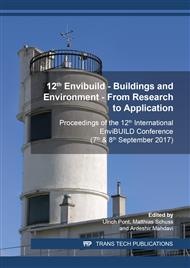[1]
Compare: D. Barber, The Thermoheliodon. Climatic architecture at the end of calculation, A+R+P+A Journal. (0) (2014). Information on http://www.arpajournal.net/thermoheliodon.
Google Scholar
[2]
See also: https://www.oib.or.at/de/kennzeichnung-und-zulassung-von-bauprodukten/ce-kennzeichnung/bauproduktenverordnung.
Google Scholar
[3]
https://www.detail.de/artikel/haus-ohne-heizung-buerogebaeude-von-baumschlager-eberle-in-lustenau-11703.
Google Scholar
[4]
Reduce, Reuse, Recycle, was the title of German contribution at the 2012 Venice Architecture Biennale under supervision of Muck Petzet.
Google Scholar
[5]
When designing new and especially when refurbishing existing buildings, the ration between embodied energy (energy used during production, transport, recycling and disposing of construction materials) and operational energy (the expected use of energy used during the in service, period of the a building) need to be monitored precisely. It is of very little use if one succeeds in minimizing operational energy, but causes unrecyclable waste sometime in the future, that required a lot of energy to produce in the first place.
DOI: 10.1201/b19894-20
Google Scholar
[6]
R. Banham, The Architecture of Well-tempered Environment, second ed., The University of Chicago Press, Chicago, (1984).
Google Scholar
[7]
Comapere: R. Banham, The new Brutalism, Architectural Design, January (1955).
Google Scholar
[8]
G. P. Hammond, C. I. Jones, Embodied energy and carbon in construction materials, Proceedings of the Institution of Civil Engineers, Energy 161 (2008), pp.87-98. Information on.
DOI: 10.1680/ener.2008.161.2.87
Google Scholar
[9]
See: http://www.delo.si/ozadja/arhitekti-anja-planiscek-jurij-sadar-ales-vodopivec-mladi-so-ocitno-pripravljeni-precej-stvari-deliti.html.
Google Scholar
[10]
The idea of increasing or reducing the size of a space was a part of Kiyunory Kikutake's schemes for the Tower Shaped Community. The proposed housing units were designed to allow for telescopic movement and could shrink at night or extend during the day to accommodate the extended need of a non-sleeping inhabitant. Similarly, a space could shrink also during the day, when the user is spending more than 50% of the day at a place of work. See: P. Senk, Kapsula: Tipologija Druge Arhitekture, Zalozba ZRC SAZU, Ljubljana, 2015, p.129.
Google Scholar
[11]
As masterfully shown by Frank Lloyd Wright in the Robbie House. See chapter 6 in: R. Banham, The Architecture of Well-tempered Environment, second ed., The University of Chicago Press, Chicago, (1984).
Google Scholar
[12]
W. D. Kalusche, Technische Lebensdauer von Bauteilen und wirtschaftliche Nutzungsdauer eines Gebäudes, in: Festschrift zum 60. Geburtstag von Prof. Dr. Hans-Ruedi Schalcher, ETH Zürich, Cottbus, 2004, pp.3-9.
Google Scholar
[13]
E. Wutscher, Demontage und Recycling im Gebäudesektor – Eine Bewertung am Beispiel des Brettsperrholz-Bausystem, PHD Thesis: tutored by Prof. Roger Riewe, TU Graz (2017).
Google Scholar
[14]
Ibid. pp.76-82.
Google Scholar
[15]
N. Kuhnert, A. L. Ngo, Die Architektur der Differenziert-Temperierten Umwelt, Arch Plus. 208 (2012). Translation by the authors, Original text: Die Umwelt wieder ernst zu nehmen und miteinkalkulieren, sich selbst als Teil der Umwelt zu verstehen, dies sind die Ansätze eines Neuen Primitivismus, der ein erneuertes Verhältnis zur (urbanen) Umwelt einfordert.
DOI: 10.1515/9783110830965.11
Google Scholar
[16]
C. Smith, Chasing the Grail: Reconciling Priorities to improve New Housing, submitted to the online publication of AMPS (2015). Information on: http://architecturemps.com/wp-content/uploads/2016/08/Charlie-Smith_A-critique-of-housing-provision-in-cities-and-qualities-that-make-urban-houses-desirable.pdf.
DOI: 10.18411/d-2016-154
Google Scholar
[17]
Ibid. Figure 1.
Google Scholar
[18]
Information on http://www.delo.si/ozadja/arhitekti-anja-planiscek-jurij-sadar-ales-vodopivec-mladi-so-ocitno-pripravljeni-precej-stvari-deliti.html.
Google Scholar
[19]
A. Lacaton, Re Invent Inhabiting, lecture at the Faculty of Architecture, University in Ljubljana, 2016. Transcription by the authors based on the online source. Information on https://www.youtube.com/watch?v=MhFYMsvDby8.
Google Scholar
[20]
Compare recycling of construction material and management in Austria: ÖNORM 1801 or B 3151; BGBI.II Nr. 181/2015; for criteria certification for example: DGNB. Information on http://www.dgnb-system.de/de/system/kriterien/ or the criteria of LEED© Information on http://www.usgbc.org/articles/good-know-minimum-program-requirements-leed or certification for Switzerland MinErgie © Information on https://www.minergie.ch.
Google Scholar
[21]
A. Isopp, Gespräch Zahlen dürfen das Denken nicht überflüssig machen, with Hermann Kaufmann und Arno Ritter, Zuschnitt. 65, proHolz Austria (2017) 12 -15.
Google Scholar



